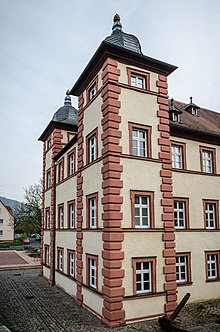Gemünden Office (Hochstift Würzburg)
The Office Gemünden (most recently Oberamt Gemünden ) was an administrative and judicial district of the County of Rieneck and the Hochstift Würzburg that existed from the 14th century to 1804 .
history
Gemünden was owned by Rieneck since the High Middle Ages. In 1278, half of the city was awarded to Count Ludwig and Gerhard von Rieneck by the Würzburg Monastery. As part of the territorialization , the Gemünden office was formed in the 14th century. Count Philip III. von Rieneck died as the last male member of his family on September 3, 1559. The Gemünden office then returned to the Würzburg Monastery as a settled fiefdom .
The statistics of the Hochstift Würzburg from 1699 name 258 subjects in 8 villages and 3 farms and mills. The following were deducted from the office as annual income for the Hochstift: Appraisal : 69 Reichstaler, excise and ungeld : 271 fl and smoke pound : 226 pounds.
In Würzburg it was referred to as the Oberamt Gemünden in the 18th century. With the Reichsdeputationshauptschluss the Oberamt Gemünden came to the Kingdom of Bavaria in 1803 . In Bavaria the office was dissolved and in 1804 the district court of Gemünden was formed instead .
scope
The Oberamt Gemünden included the city of Gemünden and the localities of Halsbach , Hofstetten , Massenbuch , Michelau , Schonderfeld , Seifriedsburg and Weyersfeld .
Official seat
After the secularization of Hirsau and his conversion to Luther's teachings, Count Philipp had the monastery church torn down and erected an expensive administrative and residential building in its place. This was available in 1556 and served as the administrative center.
Since 1726 the so-called Hutten-Schlösschen, Frankfurter Straße 2 in Gemünden, was the office building of the Würzburg district. The castle is a free-standing three-storey half-hipped roof building with drilled sandstone frames and rusticated edges as well as two corner towers with vase-crowned bell roofs. The baroque style building is marked "1711" and is a listed building .
The main court was held in a large house opposite the town hall. The place of execution was in Grauenthal, later called Krautthal.
Senior officials
- Oswald Stephan von Schölkrippen (1481)
- Otto von Kehr (1483)
- Bern. from Thüngen (1501)
- Friedrich von Schlitz (1523)
- David Truchseß von Rieneck (1536)
- Mart. From Thüngen (1538)
- Sebastian Diemer von Rieneck († 1574)
- Mart. Voit from Rieneck to Steinbach (1577)
- Wolfgang Voit von Rieneck († 1634)
- Srg. Phl. Voit of Rieneck (1650)
- Christoph Friedrich von Wachenheim (1776)
- Heinrich Christoph von Eib (1710)
- Karl Philipp Schutzbar called Milchling (1728)
- Joh.Philipp Karl Josef von Bibra (1742)
- Konstantin Freiherr von Wachenheim called Von Bechtolsheim (1746)
- Damian Fr. Franz Karl Erwein Count von Schönborn (1764)
- Mr. of Münster (1771)
- Karl Phl. From Würzburg (1773)
- Ad. Friedrich von Reichersberg (1786)
- Christoph Franz von Gebsattel (1792)
See also
- List of architectural monuments in Gemünden am Main
- Administrative organization of the Würzburg Monastery
literature
- Georg Höfling: Historical-topographical-statistical notes on the town of Gemünden in Lower Franconia and Aschaffenburg, 1838, p. 2, 111-113.
Individual evidence
- ^ Alfred Schröcker (editor): Statistics of the Hochstift Würzburg around 1700, ISBN 3-8771-7031-5 , p. 82 ff.
- ↑ Hans-Joachim Zimmermann: Courts and Execution Places in Hochstiftisch-Würzburg County and Landstätten, Diss. 1976, pp. 129–130


